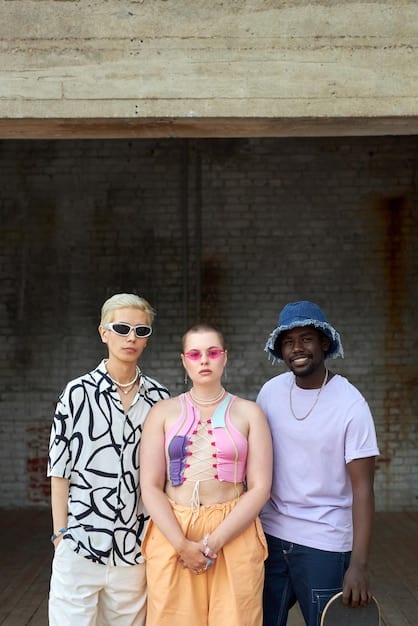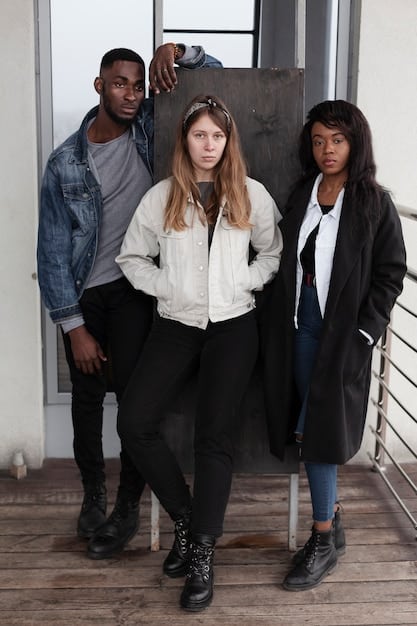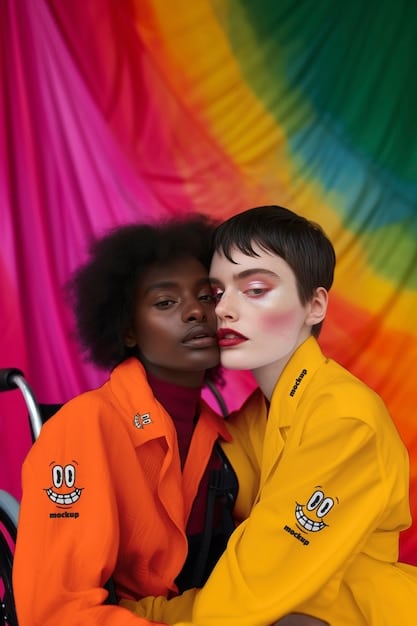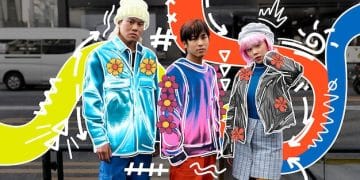Streetwear for All: Breaking Gender Barriers & Promoting Inclusivity

Streetwear for All: Breaking Gender Barriers and Promoting Inclusivity represents a pivotal shift in fashion, moving beyond traditional gender norms to embrace fluid, expressive styles that cater to diverse identities and foster a more open and equitable industry.
The landscape of modern fashion is constantly evolving, and at its forefront is the dynamic movement towards greater inclusivity. One of the most compelling manifestations of this shift is the rise of Streetwear for All: Breaking Gender Barriers and Promoting Inclusivity, a powerful trend that challenges conventional norms and invites everyone to participate in stylistic self-expression.
The Evolution of Streetwear: From Niche to Global Phenomenon
Streetwear, once a subculture rooted in skate, surf, and hip-hop communities, has transcended its origins to become a global force in fashion. Its journey from niche appeal to mainstream dominance is a testament to its inherent adaptability and cultural resonance. This evolution has paved the way for broader conversations about identity and representation, fundamentally altering how we perceive and consume fashion.
Originally characterized by oversized silhouettes, bold graphics, and collaborations with artists and musicians, streetwear offered an authentic alternative to high fashion’s exclusivity. It democratized style, making it accessible and aspirational for a younger generation eager to express individuality outside traditional dictates. This grassroots appeal fueled its organic growth and laid the groundwork for its current pervasive influence.
Tracing its Roots and Rise
To understand the current inclusive wave, it’s crucial to acknowledge streetwear’s foundational elements. It emerged from specific subcultures, each contributing distinct aesthetic and philosophical principles.
- Skate Culture: Emphasized comfort, durability, and practical apparel like graphic tees, hoodies, and loose-fitting pants.
- Hip-Hop Influence: Brought forth oversized silhouettes, prominent branding, and a swagger that challenged sartorial norms.
- DIY and Customization: Allowed individuals to personalize their attire, fostering a sense of unique identity and rebellion.
As these subcultures gained visibility, so did their signature styles. Designers and brands began to notice the undeniable impact, leading to a crucial pivot in the fashion industry. The once-distinct lines between high fashion and street style blurred, culminating in collaborations that legitimized streetwear as a significant design force.
The internet and social media further accelerated this trajectory. Platforms like Instagram became virtual runways, allowing streetwear trends to disseminate globally at unprecedented speeds. Influencers and celebrities embraced the aesthetic, cementing its status as a must-have for style-conscious individuals. This viral spread broadened its demographic appeal, setting the stage for its eventual embrace of gender fluidity.
Today, major luxury houses regularly incorporate streetwear elements into their collections, a clear indication of its enduring power. This integration signifies not just a trend, but a fundamental shift in fashion’s hierarchy, where street influence often dictates the direction of runways. The constant innovation and cultural relevance of streetwear continue to push boundaries, making it a fertile ground for exploring new expressions of identity.
The journey of streetwear, from its humble beginnings to its current global stature, perfectly illustrates how cultural movements can reshape industries. Its ability to continuously reinvent itself, while staying true to its core values of authenticity and expression, ensures its continued relevance in the ever-changing world of fashion. This historical context is essential for understanding why streetwear has become such a powerful vehicle for promoting inclusivity and breaking down gender barriers today.
Deconstructing Gender Norms in Streetwear Apparel
The beauty of streetwear lies in its inherent capacity for self-expression, a quality that inherently challenges rigid gender norms. Unlike traditional fashion, which often relies on strict binaries, streetwear’s ethos of comfort, versatility, and personal style naturally lends itself to a more fluid interpretation of what constitutes “masculine” or “feminine” attire. This deconstruction is not just about aesthetics; it reflects a deeper societal shift towards embracing diverse identities.
Historically, clothing has been used as a primary marker of gender, dictating what was deemed appropriate for men and women. Streetwear, however, with its roots in rebellion and individuality, has consistently defied these conventions. The oversized hoodies, baggy pants, and graphic tees that define much of the aesthetic are inherently non-gender conforming, allowing wearers to choose comfort and style over prescribed gender roles.
Embracing Androgynous Silhouettes
One of the most evident ways streetwear breaks down gender norms is through its prevalent use of androgynous silhouettes. Items like oversized hoodies, tracksuits, and chunky sneakers are designed with a universal appeal, making them suitable for anyone, regardless of their gender identity.
- Oversized Hoodies and T-Shirts: Offer comfort and a relaxed fit, shifting focus from body conformity to personal expression.
- Loose-Fitting Trousers and Cargo Pants: Prioritize movement and a casual aesthetic over gendered tailoring.
- Universal Jackets: Bomber jackets, denim jackets, and utility vests often feature designs that suit all body types and gender presentations.
This emphasis on fluid sizing and design encourages individuals to select clothing based on personal preference and comfort, rather than adhering to antiquated gender categories. It’s about finding pieces that resonate with one’s identity, allowing for authentic self-representation through fashion.
The move towards genderless sections in stores and online further solidifies this trend. Brands are increasingly designing collections that are explicitly marketed as “unisex” or “gender-fluid,” acknowledging that their consumer base prioritizes personal style over traditional divides. This not only broadens their market but also sends a powerful message of acceptance and inclusivity.
Furthermore, the creative freedom inherent in streetwear encourages experimentation. People are mixing and matching elements that were once considered exclusively male or female, creating unique looks that defy categorization. This blending of styles fosters a more diverse and dynamic fashion landscape where personal expression reigns supreme.
The breaking down of gender norms in streetwear is a direct reflection of a more expansive societal understanding of identity. As individuals increasingly reject restrictive labels, fashion follows suit, offering clothing that supports and celebrates this fluidity. It’s a powerful statement that clothing should serve as a tool for self-discovery, not a cage for gender conformation.
By championing comfortable, versatile, and ultimately gender-neutral designs, streetwear has carved a unique space where everyone can find pieces that resonate with their true self. This ongoing deconstruction of gender norms through apparel is a vital step towards a more inclusive and empathetic world, demonstrating fashion’s capacity for social progress.
The Rise of Gender-Neutral Collections and Brands
The fashion industry is undergoing a transformative shift, with an increasing number of brands embracing gender fluidity. This isn’t just a fleeting trend; it’s a foundational change driven by consumer demand for more inclusive and authentic fashion. The emergence of intentionally gender-neutral collections and brands is a hallmark of this new era, signaling a departure from binary marketing and design, particularly within the streetwear sphere.
These collections are designed with universal wearability in mind, focusing on fit, fabric, and silhouette that appeal across the gender spectrum. It’s about creating clothing that allows individuals to express themselves freely, unconstrained by traditional labels. Many up-and-coming designers are building their entire brand ethos around this gender-neutral principle, directly challenging the deeply ingrained conventions of the fashion world.
Pioneering Brands and Their Impact
Several brands have emerged as pioneers in the gender-neutral streetwear space, setting new standards for inclusivity and challenging the status quo. These labels are not simply offering “unisex” items as an afterthought; their core philosophy revolves around creating clothing for everyone.
- No Sesso: Known for its handcrafted, non-gendered clothing that blurs lines and celebrates individuality.
- One DNA: Specializes in gender-neutral apparel, offering stylish pieces that transcend traditional sizing and gender categories.
- Phluid Project: A vibrant retail space and brand dedicated to gender-free fashion, beauty, and accessories.
The impact of these brands extends beyond their products. They are fostering communities that celebrate diversity and self-acceptance, creating spaces where individuals feel seen and represented. By prioritizing design over gender, they are proving that inclusive fashion is not just possible, but highly desirable.
Beyond these dedicated gender-neutral brands, many established streetwear labels are also incorporating more fluid designs into their standard collections. This mainstream adoption further validates the movement, indicating that inclusivity is becoming a standard expectation rather than a niche offering. Collaborations between traditional giants and gender-fluid designers are also becoming more common, signaling a broader industry acceptance.

The shift towards gender-neutral collections also has significant implications for sustainability and consumption patterns. By designing pieces that can be worn by anyone, brands can potentially reduce waste and encourage a more conscious approach to clothing. It promotes longevity and versatility, as items are less likely to be discarded due to rigid gender associations.
Ultimately, the rise of gender-neutral streetwear is more than a commercial strategy; it is a cultural imperative. It reflects a growing collective desire for a world that is more accepting, fluid, and reflective of the diverse identities that exist. These brands and collections are not just selling clothes; they are selling a vision of a more inclusive future, one stitch at a time. Their increasing prominence demonstrates that true innovation in fashion lies in breaking down barriers, not building them.
The Role of Celebrities and Influencers in Promoting Inclusivity
In the age of digital media, the power of celebrities and influencers to shape trends and societal perceptions is undeniable. When it comes to promoting inclusivity in fashion, particularly within the streetwear realm, their role is paramount. By embracing gender-neutral styles and openly advocating for diversity, these public figures normalize fluid fashion choices and inspire millions to embrace their authentic selves. Their platforms provide unprecedented visibility for inclusive messages, far beyond traditional advertising campaigns.
Their conscious decision to wear designs that defy traditional gender norms sends a powerful message, demonstrating that style is about personal expression, not rigid categorization. This visual representation is crucial for shifting mindsets and making inclusive fashion feel attainable and desirable for a broader audience. It moves the conversation from abstract ideals to tangible, aspirational aesthetics that resonate with everyday consumers.
Mainstream Endorsement and Visibility
When high-profile individuals champion gender-neutral streetwear, it grants the movement significant mainstream endorsement. This visibility is critical for challenging long-standing fashion biases.
- Red Carpet Appearances: Celebrities often use high-profile events to showcase non-binary fashion, sparking global conversations.
- Social Media Content: Influencers regularly share outfit-of-the-day posts and style guides that highlight gender-neutral pieces, providing inspiration and breaking down stereotypes.
- Brand Collaborations: Many celebrities partner with brands to release gender-fluid collections, directly influencing design and market availability.
Beyond simply wearing the clothes, many influencers actively use their voices to advocate for a more inclusive fashion industry. They share personal stories, discuss the importance of representation, and call attention to brands that are genuinely committed to diversity. This educational aspect of their work helps to deepen public understanding and acceptance of gender fluidity in fashion.
Moreover, the global reach of social media means that these messages transcend geographical boundaries. A celebrity wearing a gender-neutral outfit in Los Angeles can influence fashion choices in Tokyo or London almost instantaneously. This rapid dissemination of inclusive ideals helps to create a worldwide community that values diverse expressions of style.
However, it is also important to note that the influence of celebrities and influencers can be a double-edged sword. Authenticity is key; consumers are increasingly savvy and can distinguish genuine advocacy from tokenism. The most impactful figures are those who not only wear the clothes but also embody the values of inclusivity and work towards meaningful change within the industry.
Ultimately, the role of celebrities and influencers remains vital in the continued push for gender-fluid streetwear. By leveraging their considerable platforms, they are not just dictating trends but are actively shaping a more accepting and diverse future for fashion. Their sartorial choices and public stances contribute significantly to breaking down gender barriers, proving that fashion can indeed be a powerful tool for social progress and personal liberation.
Beyond Apparel: Inclusive Messaging and Marketing
The move towards inclusivity in streetwear extends far beyond the design of the clothing itself; it deeply permeates brand messaging, marketing strategies, and overall communication. True inclusivity requires a holistic approach that challenges conventional narratives and embraces diverse identities at every touchpoint. This means a deliberate shift from traditional gendered appeals to campaigns that resonate with a broader, more fluid audience.
Brands are increasingly recognizing that to genuinely promote inclusivity, their marketing must reflect the diversity of their consumer base. This involves thoughtful casting for campaigns, using language that is non-gender specific, and telling stories that celebrate individualism and self-expression rather than conforming to outdated stereotypes. It’s about fostering a sense of belonging and representation for everyone who engages with the brand.
Crafting Authentic Narratives
Effective inclusive marketing is not about tokenism; it’s about authentic representation. Brands are now investing in campaigns that tell diverse stories and feature a wider range of models and individuals.
- Diverse Casting: Campaigns feature models of various genders, body types, ethnicities, and abilities, reflecting the true diversity of society.
- Non-Binary Language: Marketing copy and product descriptions increasingly use gender-neutral pronouns and inclusive language.
- Storytelling Focus: Campaigns emphasize personal narratives and the freedom of self-expression, rather than prescriptive gender roles.
This shift in messaging helps to break down preconceived notions about who streetwear is “for.” By showing a wide spectrum of people confidently wearing their designs, brands communicate that their clothing is truly for “all.” It moves beyond the idea of simply selling a product to cultivating a culture of acceptance and empowerment.
Moreover, social media plays a crucial role in disseminating this inclusive messaging. Brands are leveraging platforms like Instagram, TikTok, and YouTube to create engaging content that highlights diversity and celebrates individuality. User-generated content, where customers share their own unique styles, further amplifies this message, building a communal sense of inclusivity around the brand.

However, authenticity is key. Consumers are increasingly discerning and can quickly spot performative allyship. Brands that genuinely commit to inclusive practices from design to marketing, and whose values align with their public messaging, are the ones that build lasting trust and loyalty. This means extending inclusivity beyond just campaigns to internal company culture and supply chains as well.
In essence, inclusive messaging and marketing in streetwear are about creating a powerful visual and verbal dialogue that affirms and celebrates every individual. By moving away from restrictive gendered appeals and embracing genuine diversity, brands not only broaden their appeal but also contribute to a more accepting and equitable fashion landscape. This comprehensive approach is vital for ensuring that the spirit of “Streetwear for All” becomes a pervasive reality, not just a fleeting aspiration.
Challenges and Future Outlook of Gender-Neutral Streetwear
While the momentum towards gender-neutral streetwear is undeniable, its continued growth and full integration into the mainstream fashion industry face several challenges. Overcoming ingrained societal norms, commercial obstacles, and the sheer inertia of traditional fashion systems requires sustained effort and innovation. Nevertheless, the future outlook for this progressive movement remains overwhelmingly positive, driven by evolving consumer values and a growing demand for authentic self-expression.
One primary challenge lies in the deeply embedded legacy of gendered clothing. From manufacturing processes tailored for specific body types to retail layouts that separate “men’s” and “women’s” sections, the infrastructure of the fashion industry is built on binary assumptions. Shifting this entire ecosystem requires significant investment, re-education, and a willingness to disrupt established norms. Many consumers are also accustomed to these traditional divisions, meaning education and exposure are still vital.
Navigating Obstacles and Embracing Opportunities
The path to a fully gender-neutral fashion landscape is not without its hurdles, but each challenge presents an opportunity for further innovation and deeper impact.
- Sizing and Fit: Developing universal sizing charts and designs that flatter diverse body shapes remains a continuous challenge.
- Consumer Education: Shifting consumer mindsets from gender-specific shopping habits to fluid choices requires clear communication and inspiring marketing.
- Retail Integration: Reimagining retail spaces to be more inclusive and less gender-segregated is an ongoing process.
Despite these challenges, the opportunities for growth and positive impact are immense. The demographic driving this trend – particularly Gen Z – values authenticity, diversity, and social responsibility from brands. This consumer-driven demand is a powerful force for change, pushing even large, traditional corporations to adapt their strategies.
The economic incentive is also clear: by broadening their appeal beyond gender specifics, brands can tap into a larger and more diverse market. The rise of direct-to-consumer (DTC) models and online retail has also provided a fertile ground for smaller, agile brands to innovate without the strictures of traditional brick-and-mortar limitations, allowing them to experiment more freely with gender-neutral concepts.
Looking ahead, continued innovation in fabric technology and garment construction will play a crucial role in creating truly universal designs that offer comfort and style for all. Collaboration between designers, gender identity advocates, and consumers will be key to developing solutions that not only look good but also genuinely serve the needs of diverse individuals.
The future of gender-neutral streetwear is not just about clothes; it’s about fostering a culture of acceptance, freedom, and self-love. It signifies a broader societal aspiration towards a less restrictive, more inclusive world. While the journey may have its difficulties, the sustained passion from consumers and the growing commitment from brands indicate that “Streetwear for All” is not merely a passing trend, but a fundamental evolution in how we dress and express ourselves.
| Key Point | Brief Description |
|---|---|
| 👖 Gender-Neutral Designs | Streetwear embraces fluid silhouettes, focusing on comfort and style for all genders. |
| 🌟 Influencer Impact | Celebrities and influencers normalize inclusive fashion, driving mainstream acceptance. |
| 📢 Inclusive Marketing | Brands adopt diverse casting and non-binary language to promote authentic representation. |
| 📈 Future Growth | Despite challenges, consumer demand and innovation promise continued expansion of gender-neutral fashion. |
Frequently Asked Questions About Gender-Neutral Streetwear
▼
Gender-neutral streetwear refers to clothing designed and marketed to be worn by anyone, regardless of their gender identity. It emphasizes universal appeal, comfort, and style over traditional gender-specific sizing or aesthetics, promoting fluid self-expression.
▼
Its popularity stems from a growing societal push for inclusivity and authentic self-expression. Younger generations particularly value fluidity and see fashion as a tool to express identity beyond rigid boxes, making gender-neutral options highly appealing and relevant.
▼
Brands focus on versatile silhouettes like oversized fits, relaxed cuts, and adaptable designs that suit all body types. They prioritize fabric choice, comfort, and universal appeal, often avoiding traditionally gendered details in their aesthetics and marketing.
▼
Celebrities and influencers significantly amplify gender-neutral streetwear by wearing and promoting it on their platforms. Their visibility normalizes fluid styles, making them aspirational and accessible, and encouraging wider acceptance of diverse fashion choices globally.
▼
Key challenges include overcoming ingrained industry traditions like gendered sizing and retail layouts, and educating consumers who are accustomed to binary fashion norms. However, consumer demand for inclusivity continues to drive positive innovation and growth in this sector.
Conclusion
The journey of streetwear from a passionate subculture to a global fashion powerhouse has culminated in a transformative embrace of inclusivity. “Streetwear for All: Breaking Gender Barriers and Promoting Inclusivity” is more than just a trend; it represents a fundamental shift in how we approach style, identity, and representation. By deconstructing gender norms through fluid designs, fostering gender-neutral collections, and leveraging inclusive messaging, streetwear is forging a path towards a more accepting and expressive world. Despite inherent challenges in an industry historically built on binaries, the undeniable consumer demand and the authentic commitment from pioneering brands suggest a vibrant and expansive future. This evolution demonstrates fashion’s powerful capacity to reflect and shape societal values, affirming that true style flourishes when it welcomes everyone.





